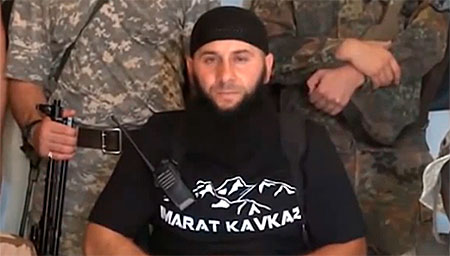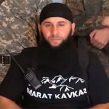
Islamist North Caucasus Rebels Training a New Generation of Fighters in Syria
Publication: Terrorism Monitor Volume: 12 Issue: 3
By:

As Syria’s bloody conflict enters its fourth year in March, it continues to provide a battlefield that attracts jihadists from all over the world. North Caucasians, including Chechens, are no exception. Previously, many reports alleged that Chechens were present in jihadi battlefields in Afghanistan, Iraq and other places; however, these claims were never proved. Syria is the first place where Chechen jihadists are indisputably taking part in fighting outside the North Caucasus.
Chechens and other Caucasians in Syria operate in four major groups, each of which is commanded by one of four prominent Chechen leaders: Omar al-Shishani, Saifullah al-Shishani, Amir Muslim and Salahudeen al-Shishani (the mujahideen announced the death of the latter via Twitter on February 6). These commanders are not related but all use al-Shishani (Arabic – “the Chechen”) as a surname.
Divisions and Unifications
Omar al-Shishani, born Tarkhan Batirashvili, comes from the remote Pankisi Gorge in northeast Georgia, populated by ethnic Chechens who emigrated from their homeland in the 19th century. Before making his way to jihad, Omar served in the Georgian military in the disputed republic of Abkhazia between 2006 and 2007. He later signed a contract in 2008 to join the Georgian army as a rifleman, but this came to an end when he was dismissed due to tuberculosis. In September 2010, he was arrested for the illegal purchase and storage of arms.
According to his own account, Omar began thinking of jihad even before he was released from prison due to his health in 2010 and left for Egypt immediately after his release. [1] When the Syrian crisis escalated, Omar entered Syria from Turkey. Inside Syria, Omar served as the leader of Jaysh al-Muhajireen wa’l-Ansar (JMA – the Army of Migrants and Supporters) before being appointed as the leader of the northern sector of the formerly al-Qaeda associated Islamic State of Iraq and Syria (ISIS) (for the JMA, see Terrorism Monitor, April 19, 2013).
When the Syrian civil war began, another Chechen commander, Saifullah al-Shishani, was already living in Turkey after leaving the Pankisi Gorge due to family disputes. He joined the JMA under Omar al-Shishani’s leadership, but later defected in September 2013 to form his own group. Controlling a small group of several dozen fighters, Saifullah announced he was joining Jabhat al-Nusra (an al-Qaeda-affiliated group) in late December, 2013. [2]
In November 2013, most of the Chechen fighters in Syria left Omar al-Shishani’s command for a “restructured” JMA under the leadership of another Chechen from Pankisi; Salahudeen al-Shishani, who was widely regarded as the representative of Doku Umarov’s Islamic Caucasus Emirate (ICE), assigned by Umarov to facilitate the unification of Caucasian fighters in Syria. [3]
Most Chechen fighters left Omar al-Shishani because they refused to pledge allegiance to ISIS leader Abu Bakr al-Baghdadi or because they had already pledged allegiance to Umarov. Others did not want to be affiliated with a group that is considered extremist, even by jihadist standards.
The fourth prominent Chechen leader in Syria is Amir Muslim, who is also from Pankisi but left the valley while still a child. He is a veteran of both Chechen wars, who was arrested by Russian authorities in 2008 but, surprisingly, released a short time later. [4] His group is Jund al-Sham, which operates independently in Latakia governorate.
Structure of the Caucasus Jihadi Units
The majority of Chechen fighters in Syria (estimates of their numbers range from 400 to 1000) are former students who were studying in Syria and Egypt before the upheavals of the Arab Spring and later played a major role in attracting others to come. [5]
After the collapse of the Soviet Union, many students left the North Caucasus to study Arabic and Shari’a in the Middle East. For the students, it was a means of re-discovering their Islamic identity. This movement persists until the present, exposing these students to a variety of Islamic ideologies in the Middle East, including Salafist-Jihadism.
Other Chechen fighters in Syria have arrived from Georgia’s Pankisi Gorge, a movement that has several causes:
- An increasing inclination towards Salafism in the younger generation;
- The near impossibility of crossing the mined and guarded northern borders to join the ICE’s jihad against Russia;
- The geographical proximity of Turkey, the gateway for foreign fighters traveling to Syria, and;
- The relative ease of travel as Georgian citizens.
Another source of recruitment is young Chechens from the European Union, part of the Chechen refugee community of some 150,000 to 250,000 people. Syria represents an opportunity to honor Islam for Chechens who cannot return to their homeland, where the pro-Russian government of Ramzan Kadyrov pursues all those tied to the Chechen independence movement. Most Chechens in the EU fall into that category. [6]
The last group consists of those few Chechens who were able to successfully pass the intense scrutiny of the intelligence agencies inside Chechnya and were able to travel to Syria. Only a few cases in this category have been reported. [7]
Training and Organizing Chechen Volunteers in Syria
When a Chechen fighter arrives in Syria to join large militias such as the JMA, he goes through various phases of training and preparation. Newcomers hand over their documents to the amir and then enroll in military training for 30 to 45 days unless they are jihad veterans with one year’s experience or military veterans with professional military training. There are also restrictions on the newcomers’ mobility – “during the first four months they are not allowed to travel outside Syria. Only after this period can a person leave for personal or family reasons… During the fighter’s presence in Syria the group allocates him money and food.” [8]
These phases reflect how Chechens in Syria aim to establish coherent groups, but also demonstrate that they are looking to Syria as a preparation ground for their own protracted conflict with Russia back home. A source close to Chechen fighters in Syria, who requested anonymity, said that Caucasian fighters are getting training in Syria. This is especially important because they have had limited success establishing training camps in the North Caucasus due to government resistance and a lack of resources. [9]
Indeed, ICE leader Doku Umarov had expressed his reservations concerning young Caucasians flocking to Syria. [10] Though he is in Syria himself, even Salahudeen al-Shishani stated in a message to his fellow fighters in the Caucasus that “without good reason, people from the areas where jihad is on-going such as… our Caucasus should not flock to Syria.”
While acknowledging that jihad is “easier in the Levant,” Salahudeen said “it’s better to wage jihad in the Caucasus, where Moscow and the Russian infidels fought us for centuries.” Salahudeen also expanded on the priority that must be given to the jihad back home, urging his fellow fighters to “be prepared for the so-called ‘Sochi Olympics’ This is a clear and direct order from our Amir, Doku Abu Uthman [i.e. Doku Umarov].” [11]
It seems that Umarov eventually realized, or had to accept, the importance of Syria as a training ground for Caucasian fighters, revising his views in a video in which he admitted to diverting young fighters to Syria due to a lack of resources in the North Caucasus. [12]
Conclusion
A source close to Chechen fighters in Syria stated that some Caucasians have returned to the North Caucasus already. This would mean that they have finished their required four months of training and that the ICE is now benefitting from the Caucasian presence in Syria. [13]
The impact of the Syrian crisis will not be limited by its borders. The conflict is attracting foreign fighters from various parts of the world, providing militants with training and ideology. With fighters from across the North Caucasus joining the Syrian jihad, the impact of their return will be felt across the entire region.
Murad Batal al-Shishani is an Islamic groups and terrorism issues analyst based in London. He is a specialist on Islamic Movements in the Middle East and in the North Caucasus.
Notes
1. “Interview with Omar Shishani,” Sena al-Sham (a jihadist paper released in Syria), October 10, 2013, https://alplatformmedia.com/vb/showthread.php?t=31592.
2. See: https://www.youtube.com/watch?v=ZPiaYXAoNVM&feature=youtube_gdata_player.
3. Salahudeen announced the new structure on November 15, 2013: https://www.youtube.com/watch?v=-2NgNi_m9z0.
4. A high quality video biography of Amir Muslim was available in several languages on YouTube, but all materials relating to Amir Muslim or his group were removed when the YouTube account was recently terminated: https://www.youtube.com/watch?v=qLR7x0Jxvw8, accessed November 5, 2013.
5. Interview with a local Imam in the Pankisi Gorge, October 2013.
6. For examples of young Chechens from the EU joined jihad in Syria, see: https://the-war-diaries.com/?p=3399 and https://www.sueddeutsche.de/politik/deutsche-im-syrischen-buergerkrieg-mein-mann-ist-ein-schahid-1.1644758.
7. See: https://echokavkaz.blogspot.co.uk/2013/09/blog-post_19.html?m=1.
8. Interview with Salahudeen Shishani published on Kavkaz Center, https://www.kavkazcenter.com/eng/content/2013/08/25/18201.shtml.
9. Author’s interview with a source close to Chechen fighters inside Syria via a social media medium, August 7, 2013.
10. See Mairbek Vatchagaev, “Caucasus Emirate Reverses Position on Syrian Jihad,” North Caucasus Weekly, June 28, 2013, https://www.jamestown.org/single/article_id=41093&no_cache=1#.UvDVA3n0sxJ.
11. See: https://www.kavkazcenter.com/arab/content/2013/07/31/9072.shtml.
12. See: https://www.youtube.com/watch?v=xXxOi8rfDrA.
13. Author’s interview with a source close to Chechen fighters inside Syria via social media, August 7, 2013.





